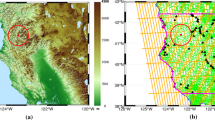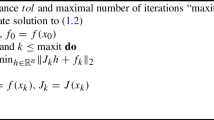Abstract
We address a claim frequently raised by one author that determination of Earth’s gravity field by satellite observations using traditional methods is mathematically flawed. Specifically, attention is drawn to the practice of setting to zero the initial sensitivity matrix in the variational equations for force model parameters. It is asserted that this would lead to mathematical contradictions. In this paper we establish necessary and sufficient conditions for the initial sensitivity matrix to be zero—conditions that are well founded and accepted worldwide in classical satellite-based determinations of the gravity field. To claim otherwise is shown to be without basis. We inspect a proposed counterexample, and find it, too, requires zero initialization of the sensitivity matrix. In addition, we review proofs and derivations from a classic textbook that also confirm zero initialization. In a numerical exercise, perfect, synthetic data for the central force problem are processed with standard procedures, and results confirm the validity of zero initialization of the sensitivity matrix.

Similar content being viewed by others
Data availability
Data sharing is not applicable to this article as all simulated data are established from scenario parameters published in this article.
References
Beutler G (2005) Methods of celestial mechanics. Springer-Verlag, Berlin/Heidelberg. https://doi.org/10.1007/b138225
Blanchard P, Devaney RL, Hall GR (2012) Differential equations, 4th edn. Brooks/Cole, Boston, MA, p 834
Coddington EA, Levinson N (1955) Theory of ordinary differential equations. McGraw-Hill Inc., New York
Jäggi A, Arnold D (2017) Precise Orbit Determination. In: Naeimi M, Flury J (eds) Global Gravity Field Modeling From Satellite-to-Satellite Tracking Data. Springer International Publishing, Cham, pp 35–80. https://doi.org/10.1007/978-3-319-49941-3_2
Montenbruck O, Gill E (2000) Satellite orbits: models. Springer-Verlag, Berlin, Methods, Applications. https://doi.org/10.1007/978-3-642-58351-3
Shampine LF, Watts HA (1980) DEPAC – design of a user oriented package of ODE solvers. Report SAND79-2374. Sandia National Laboratories, Albuquerque, NM, p 88
Xu P (2009) Zero initial partial derivatives of satellite orbits with respect to force parameters violate the physics of motion of celestial bodies. Sci China Ser D 52:562–566. https://doi.org/10.1007/s11430-009-0049-4
Xu P (2015) Zero initial partial derivatives of satellite orbits with respect to force parameters nullify the mathematical basis of the numerical integration method for the determination of standard gravity models from space geodetic measurements. Geophys Res Abstract 17:EGU2015
Xu P (2018) Measurement-based perturbation theory and differential equation parameter estimation with applications to satellite gravimetry. Commun Nonlinear Sci Numer Simulat 59:515–543. https://doi.org/10.1016/j.cnsns.2017.11.021
Xu P (2021) Reconstruction of mathematical foundations for satellite gravimetry from tracking: solutions to problems incorrectly solved for 100 years. IAG 2021 Abstract Book, Scientific Assembly of the International Association of Geodesy, Beijing, June 28-July 2, 2021.
Acknowledgements
Our special thanks go to Professor Jürgen Kusche, Dr.-Ing. Anno Löcher, and an anonymous reviewer; whose thoughtful comments were very helpful in improving this paper. We thank Dr. Xiaopeng Li, National Geodetic Survey, NOAA, for inviting us to a webinar on orbit determination which ignited our curiosity. A helpful comment by Prof. Artem Novozhilov crystalized the Coddington and Levinson proof regarding the initial condition of the sensitivity matrix. We thank L. F. Shampine and H. A. Watts for writing the DDEABM differential equation integration software package. Thanks to the organizers of the SLATEC mathematical library and to NETLIB for hosting the Fortran 77 version of the DEPAC collection.
Rights and permissions
Springer Nature or its licensor (e.g. a society or other partner) holds exclusive rights to this article under a publishing agreement with the author(s) or other rightsholder(s); author self-archiving of the accepted manuscript version of this article is solely governed by the terms of such publishing agreement and applicable law.
About this article
Cite this article
Milbert, D., Jekeli, C. On the initialization of the sensitivity matrix in variational equations. J Geod 97, 88 (2023). https://doi.org/10.1007/s00190-023-01776-4
Received:
Accepted:
Published:
DOI: https://doi.org/10.1007/s00190-023-01776-4




